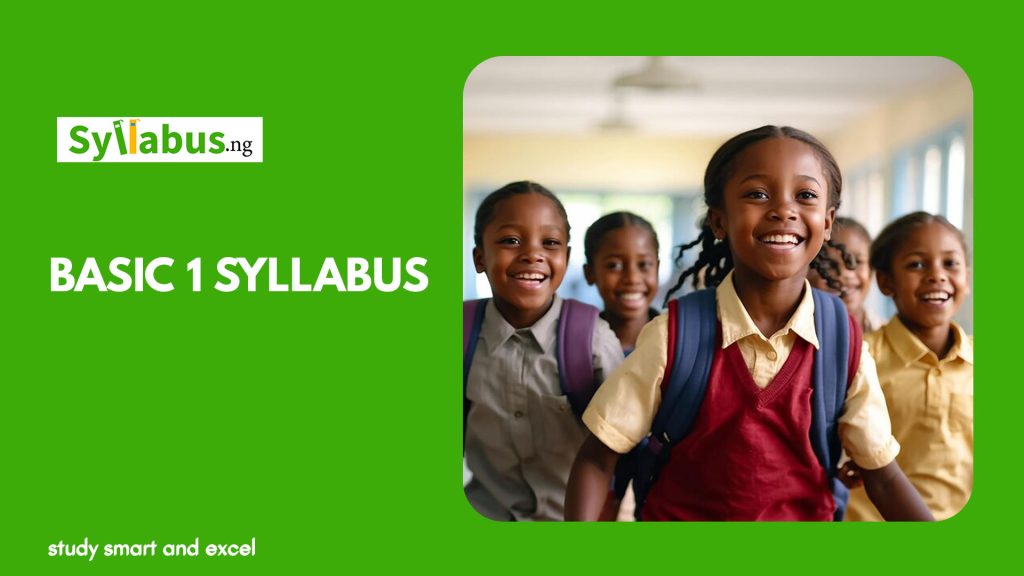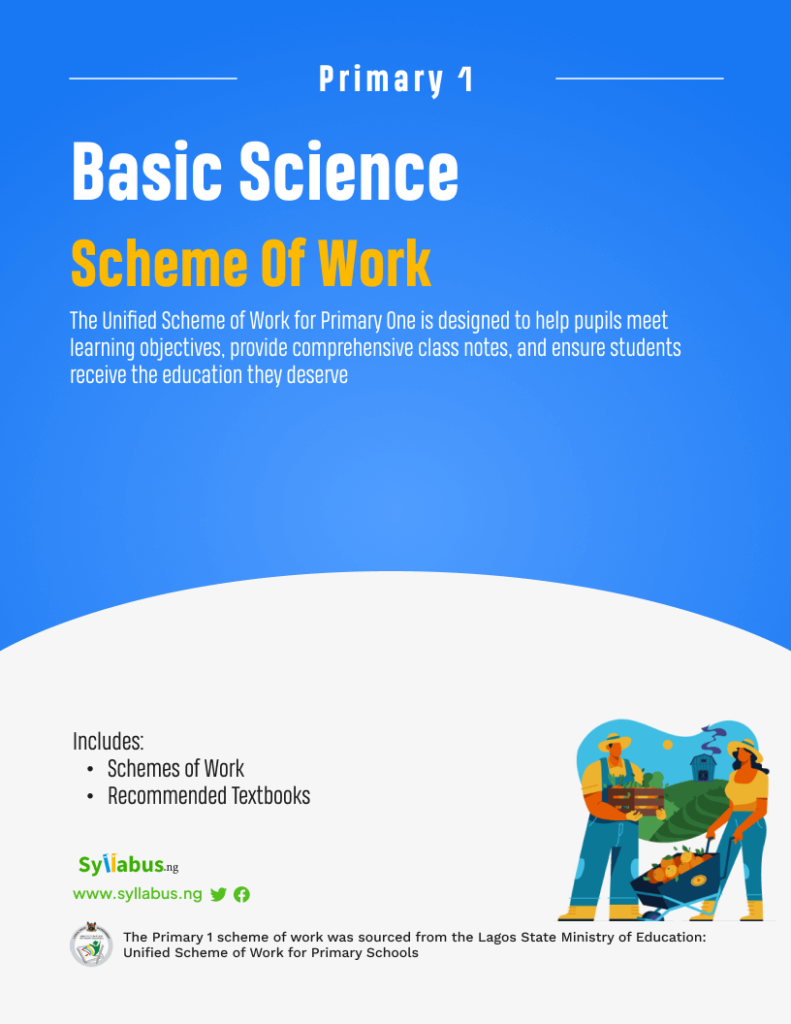Download the Unified Basic 1 Scheme of Work for Basic Science, to serve as a guide for educators and primary school teachers

Home » Primary 1 Scheme of Work » Primary 1 Basic Science Scheme of Work
The Basic Science for Primary 1 serves as a tool used to introduce the pupils to science. The topics are split into broad themes: Living and Non-living things and each of these themes covers different topics such as Energy, Water, Soil, colour, machines, transportation etc will be treated. These selected topics aim to make them familiarize themselves with Living and non-living things.
Instructors should communicate these new terms properly to the student, to ensure proper assimilation. Examples should also be given and they should be asked to relate it to real-life experience.

Know what’s expected of you as an educator
Download the Lagos State Unified Scheme of Work for Primary 1 Basic Science
| LAGOS STATE GOVERNMENT MINISTRY OF EDUCATION UNIFIED SCHEMES OF WORK FOR PRIMARY SCHOOLS. | ||
| Basic Science Scheme of Work for Primary/Basic 1 | ||
| CLASS | Primary/Basic 1 | |
| SUBJECT | Basic Science & Technology | |
| TERM | First Term | |
| WEEK | TOPIC | Learning Objectives |
| 1 | LIVING THINGS -Meaning of living things in the school environment. -Living things in the school environment. | By the end ofthe lesson„ pupils should be able to: i. Explain living things as things that have can bmathe, cat, move, reproduce etc.; ii. analyse examples of living bling; iii. Idendfy living things in school environment. |
| 2 | LIVING THINGS II | By the end of the lesson. pupils be able to: i. explain things that are living things, ii. mention living things at home. ii. evaluate characteristics of living things at home; |
| 3 | NON-LIVING THINGS -Meaning of non-living things -Non-living things in the classroom. -Non-livimg things at home. | By the end of the lesson. pupils should be able to; i. describe non-living things as things that has no life: they do not breath, move, eat or reproduce; ii. mention examples of non-living things in the school; iii. identify non-living things at home; iv. analyze the reason non living things at home and in school cannot eat, breath, reproduce or move. |
| 4 | ENERGY I: Meaning and uses of energy. | By the end of the lesson. pupils should be able to; i. explain the meaning of energy; ii. list things energy can be used for; iii. describe types of energy. |
| 5 | Energy Il Sources of energy; | By the end of the lessson, pupils should be able to: i.Explain energy, ii.List the source of energy; iii. explain the uses energy. |
| 6 | Energy III Energy Transformation | By the end of the lesson„ pupils should be able to: I. explain energy transformation; ii. analyse examples of energy transformation; iii. demonstrate how to transfer energy: iv. appraise enery transformations in their daily acüvities. |
| 7 | CONTINUOUS ASSESSMENT MID TERM BREAK | |
| 8 | Energy IV -Light energy sources; -Natural sources of light; -Artificial sources of light. | By the end of the lesson pupils should be able to; i. explain the meaning of light; ii. discuss the natural sources of light; iii. analyse artificial sources of light iv. assess the importance of artificial and natural light in their environment. |
| 9 | Water -Meaning -Sources | By the end of the lesson pupils should be able to; i. define the word water; ii. describe water; iii. distinguish between water and other liquids. |
| 10 | Water -Uses of Water | By the end of the lesson pupils should be able to; i. identify the composition of water; ii. describe the properties of water; iii. mention the uses of water to living things; plants, animals etc. |
| 11 | REVISION | |
| 12 | EXAMINATION | |
| CLASS | Primary/Basic 1 | |
| SUBJECT | Basic Science & Technology | |
| TERM | Second Term | |
| WEEK | TOPIC | Learning Objectives |
| 1 | Reading test/revision of last term work | |
| 2 | Existence of Air & creation of air. | By the end of the lesson, pupils should be able to i. demonstrate that air exists; ii. create air current by blowing with the mouth or using paper fan; iii. demonstrate the importance of air to living thing. |
| 3 | Demonstrating air in space | By the end ofthe lesson ,pupils should be able to i. demonstrate that air occupies space; ii. discover that air exerts pressure. |
| 4 | Soil | By the end of the lesson, pupils should be able to: i. Discover soil as other part of the surrounding; ii. Define soil; iii. Uses of soil. |
| 5 | Soil -Things found in the soil -Importance of soil | By the end of the lesson, pupils should be able to: i. Mention things in the soil as air, water, and living things; ii. state the uses of soil to plant; iii. identify the uses of soil to man and animals. |
| 6 | Light Energy, uses of light and colour | By the end of the lesson„ pupils should be able to: identify the various uses of li# lt explain the importance of colour x appraise the connection betv,reen lightand colour |
| 7 | REVIEW OF FIRST HALF TERM WORK AND ASSESSMENT | |
| 8 | COLOUR IDENTIFICATION 1: -Colors of objects. | By the end of the lesson, pupils should be able to: i. explore and identify different colours; ii. search for and collect materials of different colours; iii)draw objects and use different colours to paint them. |
| 9 | COLOUR IDENTIFICATION Il: -Road traffic light signs. | By the end of the lesson„ pupils should be able to: i. analyse road traffic signs; ii. state the function of each road traffic light signs; iii. explain roadway signs. iv. appraise the importance of road signs. |
| 10 | COLOUR IDENTIFICATION Ill: Road markings | By the end of the lesson, pupils should be able to : i) identify the colours used in road markings and traffic signs; ii. state the functions of road traffic signs. iii. interpret the road traffic signs |
| 11 | REVISION | |
| 12 | EXAMINATION | |
| CLASS | Primary/Basic 1 | |
| SUBJECT | Basic Science & Technology | |
| TERM | Third Term | |
| WEEK | TOPICS | Learning Objectives |
| 1 | Readiness test & revision of 2nd term work | |
| 2 | Simple machine -Definition of simple machine -Example of simple machines | By the end of the lesson pupils should be able to: i. define simple machines; ii. name examples of simple machines; iii. classify simple machine used at school and at home; iv. analyse the importance of simple machlnes. |
| 3 | Simple Machine -The Safe use of simple machine | By the end of the lesson pupils should be able to: i. cxplain how to safety use simple machines; ii. demonstrate the use of simple machines in a safe way; iii. analyse the dangers of not being precautious when using simple machines. |
| 4 | Concept of technology -Meaning and benefit | By the of the lesson. pupils should be able to. i. explain the meaning of technology ii. state the benefit of technology; iii. describe how things are done before and now. |
| 5 | Technology in home : – Electric Gadget | By the end of the lesson. pupils should be able to: i. explain what electricity is; ii. identify some appliances that use electricity. iii. create electrical gadget e.g toy car, torch light using battery etc. |
| 6 | Technology in Transportation: Land, Air (vehicle, train, airplane) | By end of the lesson, pupils should able to: i. compare old means of transportation and the new one; ii. mention means of transportation by land; iii. analyze transportation by air; iv. contrast between transportation by air and transportation by land. |
| 7 | MID TERM BREAK | |
| 8 | Transportation: Water | By the end of the lesson pupils should be able to: i) explain modes of transportation by water e.g yatch, ship, submarine etc, ii. analyse the advantages of transportation by water. iii. mention the disadvantages of water transportation. |
| 9 | EXPLORING YOUR ENVIRONMENT I i.Things in the classroom ii.Things around the school and at home. | |
| 10 | EXPLORINGYOUR ENVIRONMENT II i. type of road within and outside the school; ii. functions of each road | By the end of the lesson. pupils should be able to: i. analse types of road around the school; ii. classify type of roads outside the school; iii explain the functions of roads. |
| 11 | EXPLORING YOUR ENVIRONMENT III -Walking along the roads and crossing the roads -Traflic light signs | By the end of the lesson„ pupils should be able to: i. demonstrate the right and wrong way of walking on the road; ii. what to do (rules) when crossing the roads; iii. identify the traffic light signs. |
| 12&13 | REVISION AND EXAMINATION | |
Recommended Textbooks for Pupils & Educators
Main Text
Workbook
Teachers Guide

Know what’s expected of you as an educator
Download the Lagos State Unified Scheme of Work for Primary 1 Basic Science